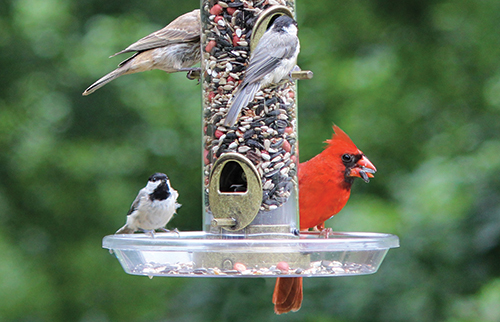
The global wild birds product market is expected to see steady growth, with a projected Compound Annual Growth Rate (CAGR) of 3.8%, reaching a market value of US$7.3 billion. This growth can be attributed to several factors:
- Rise in Backyard Bird Watching: With more people spending time at home, backyard bird watching has gained popularity as a leisure activity. This trend has led to an increased demand for bird feeders, birdhouses, and other products designed to attract and support wild birds in residential areas.
- Growing Awareness of Conservation: There’s a growing awareness among the general public about the importance of preserving and protecting wild bird populations. This heightened awareness has translated into a higher demand for products that facilitate bird conservation efforts, such as bird feeders designed to provide nutritious food for wild birds and nesting boxes to offer shelter.
- Popularity of Bird Feeding Hobby: Bird feeding has emerged as a popular hobby, particularly among older adults. This demographic segment is increasingly investing in bird feed and feeders to attract a variety of bird species to their gardens or outdoor spaces, enhancing their overall birdwatching experience.
These factors collectively contribute to the expansion of the global wild bird products market, indicating promising opportunities for businesses operating in this sector. As consumer interest in bird-related activities continues to grow, manufacturers and retailers can capitalize on this trend by offering innovative and high-quality products tailored to meet the diverse needs of bird enthusiasts worldwide.
Request a Sample of this Report! https://www.futuremarketinsights.com/reports/sample/rep-gb-12296
Business Growth Drivers:
- Increasing Awareness and Interest in Birdwatching: The growing interest in birdwatching as a hobby and leisure activity has significantly boosted the demand for wild bird products such as bird feeders, birdhouses, and bird baths.
- Urbanization and Habitat Loss: Urbanization and habitat loss have led to a reduction in natural food sources for wild birds. As a result, there is an increased reliance on supplemental feeding through bird feeders and bird food, driving the demand for wild bird products.
- Environmental Concerns and Conservation Efforts: Heightened awareness of environmental issues and the importance of biodiversity conservation has led to greater efforts to support wild bird populations. Consumers are increasingly investing in wild bird products to contribute to conservation efforts and attract birds to their surroundings.
- Innovations in Product Design and Technology: Ongoing innovations in product design and technology have resulted in more efficient and aesthetically pleasing wild bird products. Features such as squirrel-proof feeders, weather-resistant materials, and easy-to-clean designs enhance the user experience and drive market growth.
- Economic Trends and Disposable Income: Economic prosperity and rising disposable income levels in many regions have positively impacted the wild bird products market. Consumers are more willing to spend on leisure activities and enhancing their outdoor living spaces, driving the demand for bird-related products.
Industry Restraints:
- Seasonal Demand and Weather Sensitivity: The demand for wild bird products is often seasonal and heavily dependent on weather conditions. Harsh winters or prolonged periods of inclement weather can reduce bird activity and consequently impact sales of bird feeders and food.
- Competition from Alternative Leisure Activities: The wild bird products market faces competition from alternative leisure activities and hobbies. Activities such as gardening, hiking, and indoor entertainment compete for consumers’ time and discretionary spending.
- Regulatory Restrictions and Wildlife Conservation Laws: Regulatory restrictions related to wildlife conservation and bird feeding practices can pose challenges for manufacturers and retailers of wild bird products. Compliance with regulations regarding bird feeding and habitat preservation may require additional resources and investments.
- Supply Chain Disruptions and Raw Material Costs: Supply chain disruptions and fluctuations in raw material costs can affect the availability and pricing of wild bird products. Manufacturers may encounter challenges in sourcing quality materials and maintaining stable pricing amid market uncertainties.
- Pest Control and Maintenance Challenges: Managing pests such as squirrels, raccoons, and rodents can be a significant challenge for consumers using wild bird products. Addressing pest control issues and maintaining the cleanliness and functionality of bird feeders and baths require ongoing effort and investment.
Request the Full Report Methodology Now!
https://www.futuremarketinsights.com/request-report-methodology/rep-gb-12296
Global Wild Birds Products Market – Regional Analysis
North America remains one of the most lucrative markets for wild bird products globally. Presence of National Bird-Feeding Society (NBFS), in the U.S is proliferating market growth by spreading awareness about bird feeding. Bird feeding and watching is the second most favorite hobby of Americans.
The U.S, celebrates month of February as National Bird-Feeding Month, which provides remunerative growth opportunities to regional wild birds products market.
Europe is slated to be the second most lucrative region for market growth. Prominence of leading players such as CJ Wildlife Trade and effective government measure for wildlife protection, in this region and development of new technology in Europe is providing remunerative growth opportunities for global wild bird products market.
Global Wild Birds Products Market – Competitive Landscape
The global wild bird product market is slightly fragmented by presence of various regional players dominating more than 50% revenue share. These players focus upon developing efficient feeds and equipment to improvise health of birds and remain competitive in market space.
Players in the global wild birds products markets includes,
- First Nature Products
- Kettle Moraine
- Songbird Essentials
- Stokes Select
- Aspects
- Inc.
- Woodlink
- Kaytee
- Harris Farms
- LLC
- Droll Yankees
- Birds Choice
Regions and Countries Analyzed in the Report
- North America (U.S., Canada)
- Latin America (Mexico, Brazil, Rest of LATAM)
- Europe (Germany, U.K., France, Italy, Spain, Poland, Russia, Rest of Europe)
- East Asia (China, Japan, South Korea)
- South Asia (India, Thailand, Malaysia, Vietnam, Indonesia)
- Oceania (Australia, New Zealand)
- Middle East & Africa (GCC Countries, Turkey, Northern Africa, South Africa)
Report Highlights
The report is a compilation of first-hand information, qualitative and quantitative assessment by industry analysts, inputs from industry experts and industry participants across the value chain.
The report provides in-depth analysis of parent market trends, macro-economic indicators and governing factors along with market attractiveness as per segments. The report also maps the qualitative impact of various market factors on market segments and geographies.
Gain Immediate Access to Detailed Market Insights: https://www.futuremarketinsights.com/checkout/12296
Global Wild Birds Products Market – Segmentation
The global wild bird product is segmented on the following basis,
Feed type:
- Basic Seed Blends
- Feeders
- Finch and Nyjer
- Hummingbird Nectar
- Mealworm
- Premium Seed Blends
- Straight Grains
- Suet, Seed Cakes and Bells
- Wildlife
Feeder Equipment:
- Finch feeders
- Peanut feeders
- Plastic window seed feeders
- Droll Yankees
- Others
Sales Channel:
- Online retailers
- Specialized stores
- Modern trade
Author
Sneha Varghese (Senior Consultant, Consumer Products & Goods) has 6+ years of experience in the market research and consulting industry. She has worked on 200+ research assignments pertaining to Consumer Retail Goods.
Her work is primarily focused on facilitating strategic decisions, planning and managing cross-functional business operations, technology projects, and driving successful implementations. She has helped create insightful, relevant analysis of Food & Beverage market reports and studies that include consumer market, retail, and manufacturer research perspective. She has also been involved in several bulletins in food magazines and journals.
About Future Market Insights (FMI)
Future Market Insights, Inc. (ESOMAR certified, recipient of the Stevie Award, and a member of the Greater New York Chamber of Commerce) offers profound insights into the driving factors that are boosting demand in the market. FMI stands as the leading global provider of market intelligence, advisory services, consulting, and events for the Packaging, Food and Beverage, Consumer, Technology, Healthcare, Industrial, and Chemicals markets. With a vast team of ~400 analysts worldwide, FMI provides global, regional, and local expertise on diverse domains and industry trends across more than 110 countries.
Contact Us:
Future Market Insights Inc.
Christiana Corporate, 200 Continental Drive,
Suite 401, Newark, Delaware – 19713, USA
T: +1-845-579-5705
For Sales Enquiries: sales@futuremarketinsights.com
Website: https://www.futuremarketinsights.com
LinkedIn| Twitter| Blogs | YouTube




